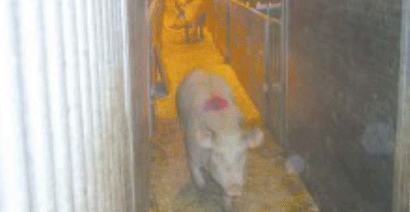



Gilt Management: Service to Farrowing
Gilt performance is a key element towards the productivity of the herd with between 20 and 25 per cent of production from gilts at any time. Investing in their future is essential, according to number 33 in the 'Action for Productivity' series from BPEX.Targets
- Farrowing rate: aim for 85 per cent
- Total born: aim for 12+
- Optimise sow longevity and reduce the number culled prematurely, i.e. before three parities.
Stotfold research has shown that lifetime productivity is not related to backfat alone but overall ‘fitness’. Body mass is important and gilts should be fed a diet that facilitates both fat and lean meat deposition. In situations where gilts have a high growth rate, or culling for leg problems has been an issue, feed intake should be restricted to 80 to 90 per cent of appetite.
Management Guidelines
Factors that should be considered when deciding the appropriate time to serve gilts include:
- System, e.g. indoors, outdoors, semi-extensive
- Housing, e.g. separate gilt groups or integrated with the sows
- Previous experience of gilts’ productivity
- Actual and expected sow longevity.
Typical service targets:
- 135 to 170kg liveweight
- 220 to 270 days of age
- Boy condition score (BCS): 3.0-3.5
By service, the gilts will have experienced at least one heat cycle and reached the required stature and body condition.
Preparing for service
Where a progestagen is used to control oestrus, there are a number of 'best practice' principles, which should be followed to ensure that at least 90 per cent of gilts are cycling five to seven days post withdrawal:
- Ensure that the gilt has already reached puberty
- Don't start the programme if the gilt is already in oestrus
- Preferably feed the gilts individually or use a new oral doser; gilts can be trained with apple juice or cod liver oil
- If group feeding, initially feed 1kg of feed plus the progestagen per gilt, distribute allowing sufficient space for the gilt to eat her allocation; feed the remaining daily allowance once the treated food has been consumed
- Once the progestagen has been withdrawn, the gilts should be placed on ad-lib feeding and receive boar contact daily to stimulate oestrus as normal.

Feeding strategy
- When gilts are not on an oestrus synchronisation programme, they are generally fed ‘to appetite’ or on an ad-lib basis up to service
- An exception to this is where growth has been restricted due to the gilts’ inherent fast daily growth and/or problems with lameness culling. These should be fed ad-lib for the cycle, or at least the last 14 days of the cycle prior to service, to flush the gilts and optimise their ovulation rate.
Familiarisation and stockmanship
- It is important that gilts are familiar with both the routine of moving to the heat detection/AI facilities and that they are also allowed to explore the area, including meeting the boars
- This will reduce stress, promote calm gilt behaviour and strong standing reflexes during insemination.

Service: Using AI effectively
- Only skilled AI operators should inseminate gilts as it can be more difficult to gauge the correct moment to inseminate and is occasionally more difficult to obtain a catheter lock
- Gilts are notorious for taking a long time to inseminate
- If you have employed a gilt familiarisation routine and have also provided a small (typically 2m x 2m) specialist AI pen with excellent boar contact, then the only options are patience or using insemination stalls and/or insemination aids.
Using natural service and AI together
If this service combination is used, then it is important that:
- The gilt is familiar with the chosen boar and service pen
- The boar and gilt body sizes are correctly matched
- Younger boars are supervised and not over worked
- The boar service should be the first service in the oestrus period, followed 18 to 24 hours later with an artificial insemination.

Service to first farrowing
- Some producers feed a gilt rearer diet during the first gestation
- Gilt rearer diets generally contain a higher level of lysine (0.7 per cent), which promotes further deposition of body lean tissue as the gilt grows and matures
- Advice on diet curve and specification should be obtained from the unit veterinarian, genetics supplier and nutritionist.
First lactation
- This is a critical time for the gilt
- Reducing anxiety by following the recommended guidelines will make the experience easier
- It is important that loss of body condition is minimised whilst ensuring that udder function is maximised by her suckling a litter of 10 to 12 piglets
- Feeding a high specification lactation diet containing at least 1% lysine and 14.5MJ DE per kg and employing feeding regimes to encourage daily intake is essential
- Maintain room temperature between 16–18ºC
- Ensure good supply (2.0 l/min) of clean water and consider providing extra water at feeding
- Use the Stotfold feeding curve to gradually increase daily intake and prevent'stalling'
- Feed three times a day for at least the last week of lactation.
May 2013








